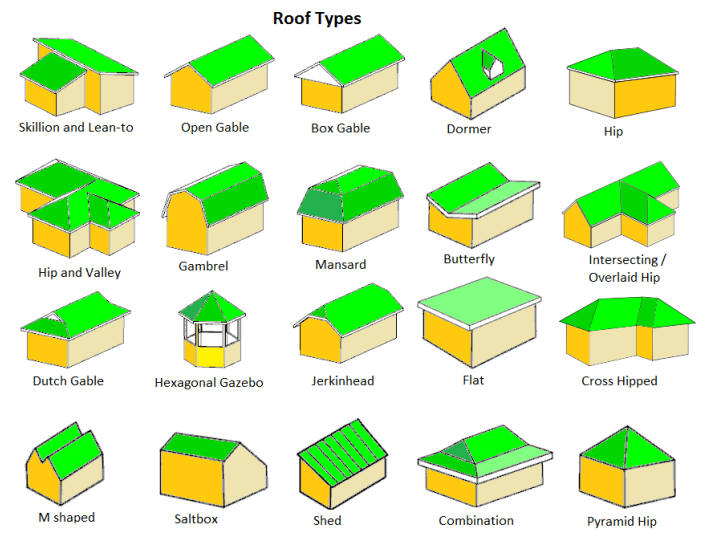Which Type of Roof Should I Build Hip or Gable?
Which Type of Roof Should I Build Hip or Gable? Are you designing your new home? So, this is the perfect moment to define some critical roofing & structural characteristics. By making the right choices when designing your house, you will seize the most of it over the years. In this sense, a crucial decision is choosing the right type of roof for your home.
All types of roofs have the same objective: to protect families and their homes. Most of them are sloped so the rainwater and melting snow can slide down to the gutters. But, what type of roof should I give to my home?
We can classify roofs according to their materials, but also according to their shape. Here, we’ll show you the types of roofs by their structure and the criteria you need to select the best for you.

In both Atoka and the Memphis, TN area, you will usually find two types of residential roofs. They are the hip roofs and the gable roofs.
Where is the difference between them? It is on the slopes on its sides.
A gable roof has two slopes extending from the ridge’s peak to the roof’s eaves. These slopes have the shape of a triangle. Meanwhile, hip roofs have four slopes joining on the roof peak and descending to the house’s walls.
Next, we will describe the existing roof styles so you can select the best for your needs.
Hip Roof and Gable Roof Explained
- What is a Hip Roof?
A hip roof has four adjacent and sloping sides. Every side has the same length. All of them join at the top of the roof, forming the vertex of a pyramid.
This roof style doesn’t have vertical ends regardless of whether the house’s structure is square or rectangular. Besides, the adjacent sides slope inward forming a ridge.
You can say you have a hip roof if each roof side slopes down until finding the house’s walls. Also, the roof eaves sit on the top of the walls.
- The Pros of Hip Roofs
- Hip roofs are more stable than gable roofs. If you live in an area where strong winds and storms are frequent, this is a crucial advantage.
- They are durable and sturdy due to their inward slope. So, they are an excellent roofing option for windy areas with a lot of snow, like New England.
- The sides’ inclination eases the snow and rain sliding without standing water.
- You can add shed dormers to gain additional living space.
- The Cons of Hip Roofs
- When improperly installed, they tend to have leaks around the dormers or additional seams.
- They offer a lower attic space since each of their sides is sloping.
- Hip roofs have a more complex design. So, they require more materials and skilled personnel to install them.
- As a direct consequence of the previous con, hip roofs are more expensive than gable roofs.
However, roofing upgrades are affordable with Long Roofing, which places at your disposal several payment options.
- Hip Roofs Variants
You can find the following hip roof types:
Pavilion roof: This hip roof variation rises upon a square building. Here, all roof sides come together forming a central peak. It has the shape of a pyramid.
Mansard Roof: In this type, each roof side has two parts, each of them with different sloping angles. The lower section has a more pronounced slope than the upper one.
Half-hip roof: it also receives the name of the clipped-gable roof. This variation takes place when a gable roof includes a hip roof section sloping off the ridge. These sections are complements for gable roofs.
- What Are Gable Roofs?
Gable roofs also receive the name of pitched or peaked roofs. We can recognize them easily due to their triangle form. They have two sloping sides forming a peek at the top, and the sides end in the roof’s eaves.
This roof style is the most popular in the US because it is easy to build. Besides, they allow that rain, snow, and debris to slide down easily. The gabled roofs are installed on a framework mounted along with the house’s structure.
- The Pros of Gable Roofs
- This type of roof is excellent to shed snow, water, and debris.
- They offer space for attics, which allows ventilation for your home. So, this is a key difference if you are deciding between building a gable or hip roof.
- They have a simple design, and their building is relatively easy.
- Its simplicity makes them an affordable option compared with other roof styles more complex.
- If you combine gable roofs, you can obtain beautiful designs.
- The Cons of Gable Roofs
- Gable roofs are not so strong against strong winds or hurricanes. Hence, for those areas where strong winds hit frequently, they are not the best choice.
- These roofs require robust frames and construction, so the roof has strong support to resist strong winds.
- If the roof has a wide overhang, there is a high risk of a strong wind uplifting and detaching the roof.
Does your home has a gable roof, and you live in a windy area? Then, you must check your roof after every high-wind storm and make sure it has proper support.
- Gable Roof Variants
The variations of this roof style are the following:
Dutch Gable: this roof type is a mix of a gable roof and a hip roof. The gable roof section is on top of the hip roof. This combination offers a larger attic space.
Cross Gable Roof: this style takes place when at least two gable roofs intersect each other forming an angle. Usually, we find these roofs in houses with garages adjacent to the home or those with different wings.
Front Gable Roof: In these roofs, the gable is the front of the house, and the front door is under the gable. This design is typical of Colonial-style homes.
What’s Your Preferred Roofing Style?
The Admiral Roofing team of expert roofers has been recognized with the Owens Corning Platinum Preferred roof replacement accreditation. Only one percent of roofers in the United States reach this distinction. Therefore, our crew can install any roofing style that fits your home.
Do you already know what will be your home’s roofing style? Remind that you can always contact Admiral Roofing for a free in-home consultation. Also, you can visit us online or call us at 901-329-1500 for an estimate in Atoka, or Memphis, TN.







